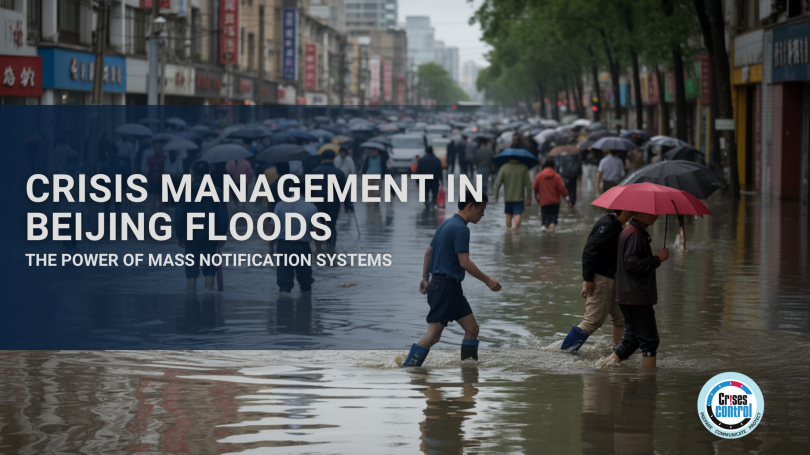In recent years, Beijing has experienced catastrophic flooding events that have tested the resilience of its infrastructure and community. The complexity of managing such disasters has underscored the importance of a robust crisis management approach, focusing on efficient communication and preparedness. In this blog, we discuss the power of mass notification systems (MNS), a technological advancement that has proven invaluable during natural disasters such as floods.
The Beijing Floods: A Brief Overview
The Beijing floods are not just a statistical anomaly but a persistent challenge. Heavy rainfall, urban planning issues, and inadequate drainage have all contributed to this problem. The situation underscores the necessity for rapid and efficient communication through an MNS.
The Catastrophe Unfolds
According to local meteorologists, the recent floods are the most severe in over a century. Remnants of Typhoon Doksuri contributed to the devastation, claiming at least 20 lives in northern China. Alongside the rainfall, more than 100 mountain roads have been sealed shut, and over 52,000 people have been evacuated as of Monday night.
Challenges in Crisis Management
Facing such an unprecedented natural disaster, the response needed to be quick, coordinated, and efficient. The conventional approaches to crisis management were put to the test, emphasising the need for innovative solutions like the MNS.
The Mass Notification System in Crisis Management
How Does It Work?
MNS provide real-time alerts, instructions, and updates during a crisis. These platforms reach various channels, such as mobile devices, email, social media, and more.
Why is it Crucial for Natural Disasters?
- Rapid Communication: Instant alerts save lives by providing timely instructions to those in danger zones.
- Unified Messaging: A consistent message across all platforms ensures clarity and avoids confusion.
- Customised Alerts: Targeted information can be sent to specific areas or groups, ensuring that the right people get the right information at the right time.
What is a Mass Notification System?
An MNS is a comprehensive solution designed to disseminate critical information promptly during a crisis. It can reach large audiences through various channels such as SMS, emails, and social media.
Mass Notification Systems in Action
In the context of the Beijing floods, MNS enabled the authorities to act quickly, relaying important safety information to those in danger. With over 52,000 people evacuated, this technology played a crucial role in saving lives
How a Mass Notification System Could Help in Beijing Floods
The recent floods in Beijing demonstrated the critical need for immediate and efficient communication systems during natural disasters. Implementing an MNS could be an invaluable asset for future crisis management in the region. Here’s how:
Integration with Weather Services for Early Warnings
By working closely with weather agencies, an MNS could provide advance alerts about potential flooding. These alerts could be location-specific, giving residents in affected areas the time to take necessary precautions or evacuate if needed.
Effective Coordination with Emergency Services
An MNS would enable streamlined communication between various emergency services like rescue teams, medical personnel, and relief agencies. Sharing real-time information could greatly enhance response times and collaboration, ensuring that help reaches those in need more efficiently.
Community Engagement and Empowerment
Engaging the local community through targeted messages and information can lead to better-prepared citizens. MNS could offer detailed guidance on safety measures, evacuation routes, and emergency shelter locations, tailored to specific areas or demographic groups.
Real-time Monitoring and Adaptive Response
Through continuous monitoring of the situation, authorities could adjust their strategies dynamically as the situation evolves. An emergency MNS would allow them to keep the public informed about any changes, enhancing trust and cooperation between officials and the community.
Accessibility through Multilingual Support
Given the diversity of Beijing’s population, offering alerts and instructions in multiple languages would be essential. This inclusivity would ensure that vital information reaches all residents, regardless of their language preferences.
Actionable Tips for Implementing a Mass Notification System
- Regularly Update Contact Information: Keeping recipient details up to date ensures that alerts reach everyone.
- Create Clear and Concise Messages: During a crisis, it is vital that communication is easy to understand and follow.
- Test the System Regularly: Regular system checks help guarantee reliability and familiarise all stakeholders with its operation.
Conclusion
The Beijing floods were a stark reminder of the unpredictable nature of natural disasters. In these trying times, mass notification systems, like those offered by Crises Control, have proven to be indispensable tools in crisis management. With the right system, countless lives can be saved, and the path to recovery can be made smoother.
Are you ready to enhance your organisation’s crisis response capabilities? Request a live demo or get in touch with an expert to discover how Crises Control can tailor a mass notification system to your unique needs. Don’t wait for a disaster to strike. Equip yourself with the tools to respond swiftly and effectively.







